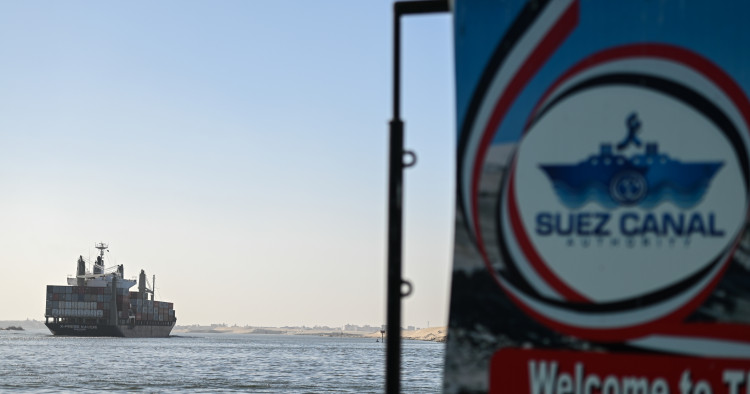Contents:
- US wrestles with friends and foes as regional crisis continues
- Trouble ahead, trouble behind for Biden’s Middle East policy
- Ongoing Lebanon-Israel clashes highlight long-running border dispute
- Striking the Houthis will not be enough; Iran must also be deterred
- Trilateral demining task force will ease but not resolve Black Sea navigation restrictions
US wrestles with friends and foes as regional crisis continues
Paul Salem
President and CEO

-
In Yemen, Iraq, and Syria, US attacks on militias allied with Iran aim to deter militant groups, and their Iranian backers, from any serious escalation, although the jury is still out as to whether this deterrence is working.
-
The US and Israel are increasingly at odds over issues such as the timetable for military operations in Gaza, the vision for postwar governance, and the potential for a large-scale diplomatic effort to revive a pathway toward a two-state solution.
As the war in Gaza burns on and its regional repercussions continue to reverberate, the United States is struggling to deter foes, while trying to ensure its friends are on the same page.
US strikes on Houthi positions inside Yemen aim to deter the militant group, and its Iranian backers, from any serious escalation in the Red Sea. In Iraq and Syria, US attacks on militias allied with Iran carry the same message. In all three of those arenas, the jury is still out as to whether this deterrence is working: The Houthis vowed to keep up their attacks in the Red Sea, and the Islamic Revolutionary Guard Corps (IRGC) claimed responsibility for an attack yesterday, near the US consulate in Erbil, Iraq, which Tehran purports was an Israeli spying location; but we have not seen a major escalation beyond those incidents either. In Lebanon, meanwhile, the US is trying to mediate between Israel and Hezbollah to avoid a full-scale escalation there.
A policy of what we can call “limited and measured escalation” suits Iran just fine. It does not want a large flare-up with the United States — or Israel — but it hopes that raising and sustaining the costs for the US in the region is both popular in Arab and Muslim public opinion and unpopular with American voters in an election year. Iran’s long-term strategy is to push the US out of more parts of the Middle East. The low-hanging fruit for the Iranians might be the US military presence in both Syria and Iraq.
It’s additionally clear that the US has also been wrestling with its friends during this crisis. Relations between President Joe Biden and Israeli Prime Minister Benjamin Netanyahu are reportedly at a serious low. The US is disappointed at the Israeli timetable in the Gaza Strip, having expected a much more rapid shift away from large-scale military operations to a more targeted approach — Israel had indicated such a shift in northern Gaza but not the rest of the strip. Netanyahu is also rejecting the US vision for governance in postwar Gaza; the US sees the Palestinian Authority (PA) as playing a central role in that order, while Netanyahu opposes such an outcome and even refuses to release the tax revenues the PA is due. Netanyahu is also very much not on board with a postwar large-scale diplomatic effort to revive a pathway toward a two-state solution. The Biden administration hopes that dangling the prospect of normalization with Saudi Arabia might help eventually sway the Israeli prime minister — or his successor.
Interestingly, Defense Minister Yoav Gallant has staked out a few positions divergent from Netanyahu’s — calling for a multinational task force for postwar Gaza, and talking about the necessity of a “diplomatic path” after the war. This divergence hints at the political rivalries that are likely to play out in Israeli politics during 2024.
At the same time, all of America’s friends and partners in the Gulf Cooperation Council (GCC) are urging the US to lean on Israel to bring its war in Gaza to a rapid end. The Abraham Accords countries have held to their normalization agreement with Israel, and Saudi Arabia is still indicating its interest, but the bar for expanding the accords has been set higher, which includes, of course, an end to the war in Gaza but, more importantly, also a pathway toward a two-state solution. On Yemen, there is surely much schadenfreude, as the Biden administration came into office heavily critiquing Saudi Arabia and its partners for their war on the Houthis, and now the US has been forced into an anti-Houthi war of its own. Saudi Arabia and the United Arab Emirates have gained a fragile détente with the Tehran-supported Yemeni separatist group through their normalization with Iran, and they don’t want to risk that security by backing US efforts in Yemen that — for the time being at least — are linked to Israel’s war in Gaza and US support for that, not to other regional issues.
On the positive side of the ledger, it is important to note that while the region is experiencing medium-level conflict in several arenas, from the Levant to the Red Sea, the probability of large-scale escalation remains low. And while Israeli military operations continue in Gaza, Defense Minister Gallant has signaled the gradual transition to lower-intensity operations. There is also much to be said for the vigorous US diplomacy that is being led by Secretary of State Antony Blinken and his team; those efforts might yet avoid full escalation in Lebanon, as well as in the Red Sea, Iraq, and Syria. Finally, the Biden team is at least laying out the right roadmap for postwar Gaza governance that includes a wide diplomatic pathway for bringing back a two-state solution as the eventual goal.
Follow on Twitter: @paul_salem
Trouble ahead, trouble behind for Biden’s Middle East policy
Brian Katulis
Vice President of Policy

-
Regional tensions continue to ratchet up, with flashpoints in Iraq, the Red Sea, Lebanon, and the Gaza Strip straining America’s broader approach in the region.
-
Gaps between America and its closest regional partners remain wide on key issues, including the end game in the Israel-Hamas war.
“You okay?” John Kirby, President Joe Biden’s National Security Council coordinator for strategic communications, asked reporters after Air Force One experienced turbulence during a press gaggle last week, as Biden headed to another domestic policy and reelection focused event in Pennsylvania.
The turbulence interrupted Kirby’s answers to a series of questions about the Biden administration’s overall approach to the Middle East, only a few hours after American and British forces hit several locations in Yemen used by the Houthis to attack international shipping in the Red Sea over the past few weeks.
The Biden administration has faced three different types of turbulence in its Middle East policy this past week: a long and growing list of threats in the region itself, some continued domestic political challenges to its Middle East approach, and internal disarray on its own team.
Starting with the last factor, the Biden team can most easily address its internal disorganization since this aspect is one it can control the most. The news that Biden’s Defense Secretary Lloyd Austin was hospitalized last month and spent several days in intensive care without notifying the commander-in-chief, at a time when the United States has stepped up military operations in the Middle East, is inexplicable but fixable and avoidable in the future. The Biden administration also faces the continued challenge of dissent from within its own ranks about its regional policies, with threats of walkouts in protest at various agencies, though absent many significant staff resignations yet.
This internal dissent is linked to a second factor: some domestic political criticisms and discontent with Biden’s Middle East approach. It remains to be seen how much the voices raised in continued protests will matter when it comes to shaping electoral outcomes in the upcoming November elections. The center of gravity in America’s political debates remains mostly focused on domestic issues, and it is unclear how much the Middle East policy debates are or may become a top concern of voters outside of the elite circles of advocacy groups.
The biggest source of turbulence right now is what’s happening in the region itself; and here, the Biden team continues to fall short of achieving progress on the five main goals it set at the outset of the war sparked by Hamas’s Oct. 7 attack on Israel. The Biden team has backed Israel’s right to defend itself and endorsed the latter’s goal of eliminating the threat posed by Hamas. But it remains unclear how well this campaign is working to restore deterrence and security. Less than half of the hostages seized by Hamas and other groups on Oct. 7 have come home safely. Meanwhile, efforts to protect civilians in the Gaza Strip and deliver humanitarian aid have not met even the administration’s own expectations. And despite stepped up discussions with regional partners about what the shared end goals on the Israeli-Palestinian front might look like, there’s nothing close to an actual plan as the combat continues in Gaza. On the Israeli-Palestinian endgame, the gaps between the US, Israel, and America’s Arab partners remain considerable.
Yet the most worrisome source of turbulence comes from the lack of progress in preventing a wider regional escalation. Events over the past week, including continued attacks in the Red Sea, Yemen, Lebanon, Syria, and Iraq — along with the ongoing Gaza conflict — all point to a weakness in the approach the Biden team set for its policy when this conflict started more than a hundred days ago.
The turbulence of the past few weeks may point to further trouble ahead.
Follow on Twitter: @Katulis
Ongoing Lebanon-Israel clashes highlight long-running border dispute
Randa Slim
Senior Fellow and Director of Conflict Resolution and Track II Dialogues Program

-
While linked to the war on Gaza, the current clashes along the Lebanon-Israel border are not a new phenomenon and follow the same calibrated, incremental, and proportional tit-for-tat pattern as previous ones.
-
Both sides say that they remain committed to a diplomatic solution to the border escalation, and Washington has floated the idea of trying to mediate the long-standing dispute over the land border, an effort that has taken on renewed urgency given the recent clashes.
Fierce clashes have continued along the Lebanon-Israel border since Oct. 8, 2023. While linked to the war on Gaza, these clashes are not a new phenomenon. Although they may be different from previous border clashes in both scope and intensity, they follow the same calibrated, incremental, and proportional tit-for-tat pattern.
Israeli officials are increasingly threatening that these border clashes will eventually drag Lebanon into a highly destructive all-out war with Israel. Hezbollah officials counter that any such war will be equally costly for Israel. Yet both sides continue to say that they remain committed to a diplomatic solution to the border escalation.
Hezbollah has conditioned any negotiations over this issue on an end to the war in Gaza. Hezbollah Secretary-General Hassan Nasrallah has indicated in his speeches that the primary objectives of this border escalation are to lend support to Hamas and bring the war in Gaza to an end.
Lebanon and Israel have a history of border clashes, the most recent of which were last June, when Israel claimed that Hezbollah had set up tents near Ghajar, a disputed village between Lebanon and Israel, to shelter its fighters on Israeli territory. Last July, fire exchanges between the two sides wounded three Hezbollah members; a few Lebanese journalists and members of parliament were also targeted by Israeli tear gas along the border.
There is no internationally recognized land border between the two countries since both parties have so far not agreed to delineate it. There is a 120-km “line of withdrawal,” known as the Blue Line, which the United Nations published in June 2000 following the Israeli withdrawal from southern Lebanon that year to determine whether it had withdrawn in line with United Nations Security Council Resolutions 425 and 426.
Following the US’s success in brokering a maritime border agreement between Lebanon and Israel in late 2022, Washington is once again trying to de-escalate tensions along the border in order to avert the all-out war that Israel is threatening to drag Lebanon into.
At the heart of this conflict are 13 disputed land border points, 7 of which have already been settled in past US-mediated indirect negotiations between the two sides. Of the six remaining disputed border points, two will be particularly challenging to settle: the B1 point, located in Lebanon’s Ras Naqoura, which Beirut considers the starting point of its southern land border; and what Lebanon calls the “Wazzani reservation,” which extends to the M9 point that lies at the junction of the Wazzani River before continuing into the Israeli-occupied Golan Heights.
Last August, at the end of a two-day visit to Lebanon, US Special Envoy Amos Hochstein announced that Washington was exploring the possibility of mediating the land border disputes between Lebanon and Israel. That effort remained in an exploratory phase until recently, when the military escalation along the border gave renewed urgency to reviving the prospects of negotiating a sustainable solution to the long-standing conflict. During his visit to Beirut last week, which was preceded by a trip to Tel Aviv, Hochstein noted that it is the US’s job to get to a diplomatic solution to the current border conflict between Lebanon and Israel.
According to press reports based on statements from the Lebanese prime minister’s office, Hochstein called for interim measures to calm the situation on Lebanon’s southern border while noting the difficulty of achieving a long-term solution to the border dispute. In a speech on Jan. 5, Hezbollah Secretary-General Nasrallah opened the door for indirect negotiations with the US and Israel over land border demarcation, conditioning the talks on an end to the war in Gaza. Nasrallah’s stance was a significant departure from Hezbollah’s past rejection of negotiations over Lebanon’s southern land border.
Follow on Twitter: @rmslim
Striking the Houthis will not be enough; Iran must also be deterred
Michael K. Nagata
Distinguished Senior Fellow on National Security

-
The United States is right to militarily respond to Houthi attacks on Red Sea shipping and to show that US warnings are not empty threats.
-
But the US challenge is much larger than just persuading both the Houthis and their Iranian masters to halt these maritime attacks; Iran and its network of allies and proxies must be persuaded, and if necessary compelled, to cease their threats against US and allied elements as well as to stop attacking strategically vital areas throughout the region.
The recent series of US-led airstrikes on Houthi elements in Yemen was a necessary step. International shipping in the Red Sea must be defended, especially since maritime transit via this channel is vital to global economic stability. Just as importantly, the United States had to forcefully respond to the waves of attacks by other Iranian allies on American military elements in both Iraq and Syria. The US could not afford to have its public warnings of significant consequences if these activities continued be seen by other actors in the region, or internationally, as empty threats. Other malign powers far beyond Iran, such as Russia or China, would immediately capitalize on any signs of American wavering.
And yet, these strikes are not a strategic solution, necessary though they are. The Houthis are much more than just a Yemeni tribal group that seized more than half the country in 2014, sparking an ugly, multi-year conflict that quickly drew in Saudi Arabia and its allies. Today, the Houthis are only a single part of Iran's region-wide malign network — trained, equipped, and orchestrated by Tehran — whose members include Hezbollah, Hamas, Iranian militias in Iraq, and many others. And while US strikes have certainly already harmed some of the Houthis’ capability for making mischief, much remains untouched there, and the Iranians will work quickly to shore up their losses. Meanwhile, the rest of the Iranian network can easily compensate for whatever temporary setbacks the Houthis have suffered in other ways, whether inside Yemen, or elsewhere.
This US challenge is much larger than just persuading both the Houthis and their Iranian masters to halt the maritime attacks, strategically essential though this certainly remains. So long as Iran retains the ability to nourish and effectively wield all elements of its region-wide network of allies and proxies, increasingly with capabilities enhanced by commercially available technologies, critically vital places such as the Red Sea will become more and more vulnerable. And the US cannot defend everything.
Trilateral demining task force will ease but not resolve Black Sea navigation restrictions
Iulia-Sabina Joja
Director, Black Sea Program

-
Since the beginning of Russia’s full-scale invasion in February 2022, floating mines launched by both Ukraine and Russia have constituted a major security issue for regional countries and hampered the maritime export of Ukrainian grain, thus impacting global food security.
-
The new Romanian-Bulgarian-Turkish demining task force will make an important difference to Black Sea security and to global food security at large, but the ongoing war and Turkey’s policies will continue to prevent true freedom of navigation.
Last week, a trio of Black Sea littoral countries signed the first regional security agreement that does not include the Russian Federation. Namely, the region’s three North Atlantic Treaty Organization (NATO) member states, Bulgaria, Romania, and Turkey, launched a trilateral demining naval task force. The participating signatories have pledged to pitch in minesweepers, patrol ships, helicopters, and drones to demine their territorial waters (12 nautical miles from the baseline), though their operations could also extend to their exclusive economic zones in the Black Sea. Since the beginning of Russia’s full-scale invasion in February 2022, floating mines launched by both Ukraine and Russia have constituted a major security issue for regional countries and hampered the maritime export of Ukrainian grain, thus impacting global food security.
To date, Black Sea coastal states have identified and destroyed more than 90 untethered or free-floating mines. And all three of the demining task force countries have found mines in their own territorial waters. Several commercial ships have been hit by these dangerous hazards. Most recently, a Panamanian-registered commercial ship struck a mine on Dec. 27, 2023, while it was headed to a Ukrainian port to pick up agricultural products intended for export. Ever since Russia canceled the Turkish-negotiated maritime grain export deal this past summer, Ukrainian agricultural exports intended for the Middle East, Africa, and beyond have been transported via an alternative route, along the territorial waters of Romania, Bulgaria, and Turkey.
The new trilateral demining task force will make an important difference to Black Sea security and to global food security at large by helping to ensure that the above-mentioned alternative Ukrainian grain export corridor remains clear. Indeed, this maritime route has already enabled the transport of millions of tons of products destined for the United Nations World Food Program and countries most in need. That said, even with the Romanian-Bulgarian-Turkish initiative in force, the Black Sea as a whole will remain restricted for navigation and suffer from a high level of insecurity — not only because of the war but also due to Turkish policies. Earlier this year, Turkey blocked two British-built minesweepers, destined as a donation for Ukraine, from entering the Black Sea; Ankara invoked the Montreux Convention, which gives it the right to regulate access into and out of the Black Sea via the Turkish Straits. Turkey’s minister of defense proclaimed the need to “ensure a balance of the Black Sea,” suggesting his country’s decades-old policy of blocking access to this body of water for outside powers remains unchanged, despite Russia’s ongoing aggression against its neighbor.
Follow on Twitter: @IuliJo
Photo by Sayed Hassan/Getty Images
The Middle East Institute (MEI) is an independent, non-partisan, non-for-profit, educational organization. It does not engage in advocacy and its scholars’ opinions are their own. MEI welcomes financial donations, but retains sole editorial control over its work and its publications reflect only the authors’ views. For a listing of MEI donors, please click here.













